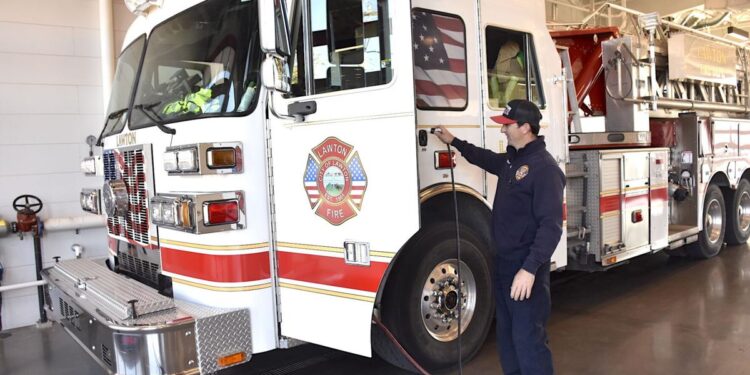Lawton Fire Department begins each day 24 people down, with four to five people on overtime. • It’s frustrating, said Fire Chief Jared Williams, of shortages that occur on both ends of the firefighting spectrum. • While fewer people are applying to the fire academy to become new firefighters, more senior firefighters are leaving the department: to retire, to jobs outside firefighting, to other departments. • Lawton Fire Department has lost 57 firefighters since 2021 and today the department has seven openings, with two captains and one assistant chief set for retirement by year’s end. • The result is simple mathematics: fewer people mean more hours for those who remain to handle critical duties. • Sometimes, adjustments can be made. For example, 24 of the 57 departures were retirements. • “We plan for that,” Williams said, adding the problem has been the unexpected departures, to include nine firefighters who left for jobs unrelated to emergency services. “That’s a new phenomenon.”
Why are firefighters leaving?
“There’s not one reason,” Williams said, adding while it is easy to point to pay — and that is a major factor — it’s not the only reason.
For the firefighter Williams lost to Norman, an incentive was the chance to join the Urban Search and Rescue Unit, a highly specialized team. Others, who already have EMT or paramedic training, want to transition into related fields.
Williams, a career firefighter who knew from a young age what he wanted to be, pointed to the growing number of people who go into public safety, then leave after several years. It seems to be more common in younger age groups, he said, adding that, coupled with those who leave for better pay in other fire departments or in medical fields, it creates a challenge.
Williams said the majority of firefighters join the department in their 20s (although he has two who became firefighters at age 18). Williams was 23, old enough to have some life experience under his belt but young enough to meet the physical demands of the job. He also had an edge: he was the son of a volunteer firefighter and the grandson of Elgin’s first fire chief, so he knew what he was getting into.
Williams said another part of the problem is the mobility of today’s work force. Because of the nature of the job, today’s firefighters don’t have to live in the communities where they work. So, while the Oklahoma City area may be about an hour’s drive, firefighters living in the Lawton area would make that drive only 10 times a month because they work the equivalent of 10 days, compared to a traditional worker who works 20 days a month.
“You see a lot of guys commute,” he said.
While firefighting may be a young man’s game, in terms of the job’s physical demands, success also relies on those with the knowledge and skills they bring to the table when they stay — and take with them when they leave. So, while the front line may be for younger people, that doesn’t mean there isn’t a role for firefighters who have been in the field 20 years or more. Williams said it is vital those senior firefighters remain with the department.
“We gain experience,” he said of the challenge of keeping senior firefighters, adding that is a change from the past when firefighters typically started and ended their careers in the same department.
Williams and others say it is the firefighters with experience who are guiding the department and training its new members. And that’s something Lawton does well.
“We’ve got good training,”Williams said, adding one of the reasons he loses firefighters to other departments is that they respect the quality of Lawton’s training.
The fire academy that Lawton runs through Great Plains Technology Center is bringing trained personnel back to the department, but not in the numbers academies once did. When Williams applied to the fire academy, he was one of 200 applicants. Lawton’s latest academy had 23 applicants, with 17 accepted. That’s the good news: while fewer people are applying, those who do apply are more skilled.
“The quality of the applicants has increased,” Williams said, crediting programs such as those offered by Great Plains Technology Center.
The academy is designed to provide the broad spectrum of training that firefighters need, and Lawton’s goal is keeping those firefighters through the six-month academy so they graduate and formally join the Lawton department. It’s a commitment from the department and the City of Lawton, Williams said, explaining they have physical and financial investment in each candidate.
City Council members say that makes it especially frustrating when academy graduates take jobs with other departments, or stay in Lawton only a short time.
Today, Lawton Fire Department’s personnel range in experience from two months to 25 years, meaning the average length of service for a firefighter is 8.3 years. When you consider most firefighters start their careers at a young age, that leads to a startling conclusion.
“We’re an extremely young department,” said Williams, as he and city administrators work to address an issue plaguing fire departments across the nation: it’s getting harder to recruit and retain firefighters. “It’s a fire service-wide phenomenon, not just Lawton.”
Want to reach a local audience and grow your business?
Our website is the perfect platform to connect with engaged readers in your local area.
Whether you're looking for banner ads, sponsored content, or custom promotions, we can tailor a package to meet your needs.
Contact us today to learn more about advertising opportunities!
CONTACT US NOW




